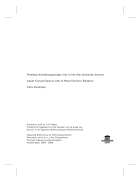




Mã tài liệu: 225724
Số trang: 206
Định dạng: pdf
Dung lượng file: 3,850 Kb
Chuyên mục: Tổng hợp
Table of Contents i
Nederlandstalige Samenvatting v
English Summary ix
List of Tables xiii
List of Figures xv
List of Symbols and Abbreviations xxv
1 Introduction 1
1.1 Background . . . . . . . . . . . . . . . . . . . . . . . . . . 1
1.2 Goal . . . . . . . . . . . . . . . . . . . . . . . . . . . . . . . 2
2 Liquid Crystals 5
2.1 Material properties . . . . . . . . . . . . . . . . . . . . . . 5
2.2 Alignment . . . . . . . . . . . . . . . . . . . . . . . . . . . 10
2.3 Electric and elastic properties . . . . . . . . . . . . . . . . 11
2.4 One-dimensional configurations . . . . . . . . . . . . . . 14
2.5 In-Plane switching . . . . . . . . . . . . . . . . . . . . . . 16
2.5.1 Director distribution . . . . . . . . . . . . . . . . . 17
2.5.2 One-dimensional approximation . . . . . . . . . . 18
3 Optical Transmission 23
3.1 Polarization of light . . . . . . . . . . . . . . . . . . . . . . 24
3.2 Jones Matrix Method . . . . . . . . . . . . . . . . . . . . . 26
3.2.1 Polarizer . . . . . . . . . . . . . . . . . . . . . . . . 29
3.2.2 Twisted nematic and anti-parallel rubbed . . . . . 29
3.2.3 In-plane switching mode . . . . . . . . . . . . . . 31
3.3 Rigorous CoupledWave Method . . . . . . . . . . . . . . 32
3.4 Reduced Grating Method . . . . . . . . . . . . . . . . . . 37
3.5 Simplified transmission model . . . . . . . . . . . . . . . 39
3.5.1 Transmission model . . . . . . . . . . . . . . . . . 39
3.5.2 Simulations . . . . . . . . . . . . . . . . . . . . . . 41
3.5.3 Experiments . . . . . . . . . . . . . . . . . . . . . . 46
4 Surface Anchoring 49
4.1 Weak and strong anchoring . . . . . . . . . . . . . . . . . 49
4.2 Modeling of weak anchoring . . . . . . . . . . . . . . . . 50
4.2.1 Expressions for the anchoring energy fs . . . . . . 51
4.2.2 Examples . . . . . . . . . . . . . . . . . . . . . . . 53
4.3 Weakly anchored in-plane switching mode . . . . . . . . 55
4.4 Measurement of the anchoring strength . . . . . . . . . . 59
4.4.1 Field-off techniques . . . . . . . . . . . . . . . . . 59
4.4.2 Field-on techniques . . . . . . . . . . . . . . . . . . 60
4.5 Flow and memory anchoring . . . . . . . . . . . . . . . . 61
4.6 Weak anchoring experiments . . . . . . . . . . . . . . . . 62
4.6.1 Cell preparation . . . . . . . . . . . . . . . . . . . . 62
4.6.2 Microscope observations . . . . . . . . . . . . . . . 63
a) Static microscope observation . . . . . . 63
b) Influence of memory alignment . . . . . 66
c) Memory alignment in the 3-GPS cell . . 67
d) Memory alignment in the BCB cell . . . 70
e) Switching and relaxation for FC4430 . . 74
4.6.3 Transmission measurements . . . . . . . . . . . . 79
a) Average electro-optic measurements . . 79
b) Estimation of the azimuthal anchoring
strength . . . . . . . . . . . . . . . . . . . 80
5 Liquid Crystal Device with a Rotatable Director 85
5.1 Structure of the reconfigurable wave plate . . . . . . . . . 86
5.2 Operating principle . . . . . . . . . . . . . . . . . . . . . . 87
5.3 Director simulations . . . . . . . . . . . . . . . . . . . . . 90
5.3.1 Simulated director distribution . . . . . . . . . . . 91
5.3.2 Purpose of the dielectric layer . . . . . . . . . . . . 95
a) Simplifiedmodel for the influence of the dielectric layer . . . . . . . . . . . . . . . 96
b) Mirror plane perpendicular to the aver-age electric field . . . . . . . . . . . . . . 100
5.3.3 Switching times of the device . . . . . . . . . . . . 103
5.3.4 Multistable wave plate . . . . . . . . . . . . . . . . 106
5.4 Optical simulations . . . . . . . . . . . . . . . . . . . . . . 107
5.4.1 General considerations . . . . . . . . . . . . . . . . 107
a) Regular rectangular mesh . . . . . . . . 107
b) Diffraction orders on a rectangular and a hexagonal lattice . . . . . . . . . . . . . 109
c) Transmissive and reflective mode . . . . 111
5.4.2 Transmissive mode . . . . . . . . . . . . . . . . . . 112
a) Crossed polarizers . . . . . . . . . . . . . 112
b) Influence of the applied voltage . . . . . 117
c) Transmission as a function of time . . . . 120
5.4.3 Reflective mode . . . . . . . . . . . . . . . . . . . . 122
a) Improvement of the JMM algorithm . . 122
b) Reconfigurable wave plate . . . . . . . . 125
5.5 Experiments . . . . . . . . . . . . . . . . . . . . . . . . . . 127
5.5.1 Production process of the reconfigurablewave plate127
a) Device design . . . . . . . . . . . . . . . 128
b) Device processing . . . . . . . . . . . . . 129
5.5.2 Measurements . . . . . . . . . . . . . . . . . . . . 132
a) Distinguishing the three different driv-ing configurations . . . . . . . . . . . . . 133
b) Control of the average director alignment 135
c) Influence of the applied potential . . . . 137
d) 360◦ in-plane rotation of the director . . 140
e) Improvements to the device . . . . . . . 141
5.6 Applications for the new liquid crystal device . . . . . . . 143
5.6.1 Hexagonal device with rubbed alignment layers . 144
5.6.2 Electric field driven alignment direction . . . . . . 144
5.6.3 Intermediate director alignment . . . . . . . . . . 144
6 Conclusion 147
6.1 Achievements . . . . . . . . . . . . . . . . . . . . . . . . . 147
6.2 Outlook . . . . . . . . . . . . . . . . . . . . . . . . . . . . . 148
Bibliography 151
List of Publications 165
Index 16
Những tài liệu gần giống với tài liệu bạn đang xem
📎 Số trang: 157
👁 Lượt xem: 397
⬇ Lượt tải: 16
📎 Số trang: 66
👁 Lượt xem: 541
⬇ Lượt tải: 16
📎 Số trang: 222
👁 Lượt xem: 553
⬇ Lượt tải: 16
📎 Số trang: 77
👁 Lượt xem: 475
⬇ Lượt tải: 16
📎 Số trang: 57
👁 Lượt xem: 644
⬇ Lượt tải: 16
📎 Số trang: 6
👁 Lượt xem: 540
⬇ Lượt tải: 16
📎 Số trang: 130
👁 Lượt xem: 742
⬇ Lượt tải: 17
📎 Số trang: 12
👁 Lượt xem: 462
⬇ Lượt tải: 18
📎 Số trang: 73
👁 Lượt xem: 591
⬇ Lượt tải: 16
📎 Số trang: 82
👁 Lượt xem: 594
⬇ Lượt tải: 16
Những tài liệu bạn đã xem
📎 Số trang: 206
👁 Lượt xem: 442
⬇ Lượt tải: 16
 Luận văn thạc sĩ tiếng Anh Liquid Crystal Devices with In Plane Director Rotation Chris Desimpel
Table of Contents i Nederlandstalige Samenvatting v English Summary ix List of Tables xiii List of Figures xv List of Symbols and Abbreviations xxv 1 Introduction 1 1.1 Background . . . . . . . . . . . . . . . . . . . . . . . . . . 1 1.2 Goal . . .
pdf Đăng bởi
president_of_vietnam
Luận văn thạc sĩ tiếng Anh Liquid Crystal Devices with In Plane Director Rotation Chris Desimpel
Table of Contents i Nederlandstalige Samenvatting v English Summary ix List of Tables xiii List of Figures xv List of Symbols and Abbreviations xxv 1 Introduction 1 1.1 Background . . . . . . . . . . . . . . . . . . . . . . . . . . 1 1.2 Goal . . .
pdf Đăng bởi
president_of_vietnam